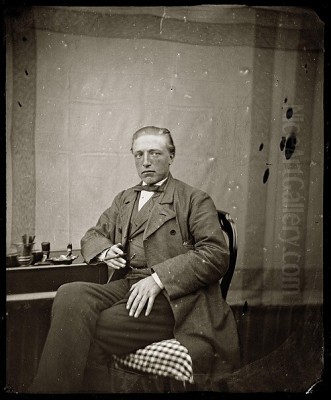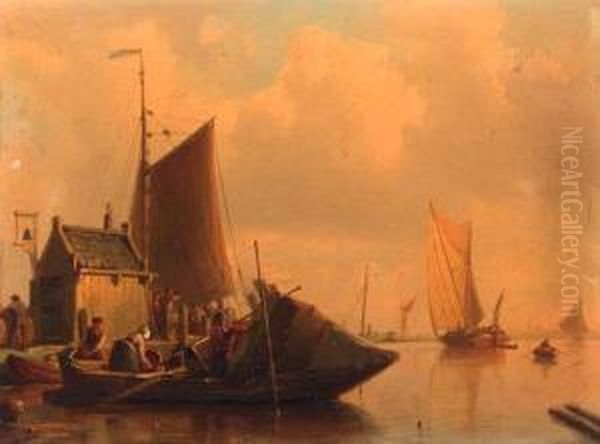
Johan Adolph Rust (1828-1915) stands as a notable figure in the rich tapestry of 19th-century Dutch art. A dedicated painter and respected educator, Rust carved a niche for himself with his evocative marine paintings and detailed depictions of urban and riverine landscapes. His work, while perhaps not as internationally heralded as some of his contemporaries, offers a valuable window into the Netherlands of his time, capturing the enduring relationship between the Dutch people, their waterways, and their cities. His long life spanned a period of significant artistic evolution in Europe, yet Rust remained largely committed to a realistic, finely rendered style that honored the traditions of Dutch painting.
Early Life and Artistic Formation in Amsterdam
Born in Amsterdam in 1828, Johan Adolph Rust emerged into a city with a profound artistic heritage. The legacy of the Dutch Golden Age, with its masters of landscape, seascape, and genre painting, still resonated deeply. While specific details about Rust's earliest artistic inclinations are not extensively documented, it is clear that he pursued formal training to hone his talents. Amsterdam, as a bustling port city and cultural hub, would have provided ample inspiration for a young artist drawn to maritime themes and the intricate beauty of urban environments.
A pivotal aspect of Rust's artistic development was his tutelage under Cornelis Springer (1817-1891). Springer was a highly esteemed painter of townscapes, renowned for his meticulous detail, his skillful handling of light and perspective, and his romanticized yet accurate portrayals of Dutch cities and villages. Studying with a master of Springer's caliber would have instilled in Rust a strong foundation in draftsmanship, composition, and the techniques of oil painting. Springer's influence can often be discerned in the careful rendering and atmospheric qualities present in Rust's own work, particularly in any city or architectural scenes he may have produced.
The Influence of Cornelis Springer and the Dutch Tradition

Cornelis Springer was not only a successful artist but also a significant teacher. His studio attracted a number of aspiring painters, and Rust was fortunate to be among them. Springer's own style was characterized by a romantic realism, often depicting sun-dappled streets, historic buildings, and lively market scenes. He was a master of capturing the unique character of Dutch towns, from grand churches to humble canalside houses. This emphasis on detailed observation and the picturesque qualities of the everyday Dutch environment undoubtedly shaped Rust's artistic vision.
Other artists who benefited from Springer's guidance or were part of his circle included Adrianus Eversen (1818-1897), who also became known for his charming Dutch townscapes, often displaying a similar attention to architectural detail and atmospheric effect. Johan Conrad Greive (1837-1891), another contemporary, focused more on river and harbor scenes, sharing Rust's affinity for maritime subjects. The artistic environment in which Rust trained was thus rich with painters dedicated to capturing the multifaceted beauty of the Netherlands, continuing a tradition established by artists like Jan van der Heyden in the 17th century.
Artistic Style: Realism Tinged with Atmosphere
Johan Adolph Rust is primarily recognized as a marine painter. His works often feature the bustling waterways of the Netherlands – its rivers, estuaries, and harbors teeming with various vessels. He possessed a keen eye for the specifics of ship construction, the play of light on water, and the ever-changing moods of the Dutch sky. His style can be described as realistic, with a strong emphasis on accurate depiction. However, his realism was not merely photographic; it was often imbued with a subtle atmospheric quality, a "touch of fantasy" as some have described it, which could manifest as a gentle haze, a dramatic cloud formation, or a particular quality of light that lent a romantic or tranquil mood to the scene.
This ability to combine meticulous detail with an evocative atmosphere is a hallmark of strong 19th-century landscape and marine painting. Rust's commitment to capturing the natural world, particularly the maritime environment, places him within a long and distinguished lineage of Dutch artists who found endless inspiration in their country's intimate relationship with the sea and its inland waters. Artists like Willem van de Velde the Younger in the 17th century had set a high bar for marine painting, and 19th-century painters like Rust continued to explore these themes with their own contemporary sensibilities.
Thematic Focus: Dutch Waterways and Maritime Life
The core of Johan Adolph Rust's oeuvre revolves around the depiction of Dutch maritime life. His canvases frequently portray scenes such as "Dutch Sailing Ships Moored at an Estuary," a title indicative of his preferred subject matter. These paintings would typically feature a variety of sailing vessels, from humble fishing boats to larger merchant ships, set against the backdrop of a calm river mouth or a busy port. The accuracy in rendering the rigging of the ships, the texture of the sails, and the reflections in the water speaks to his careful observation and technical skill.
Another representative theme, as suggested by titles like "Windmill on the Riverbank," highlights the quintessential Dutch landscape. Windmills, crucial for land reclamation and industry, were iconic elements of the Dutch countryside and often appeared in landscape paintings, including those by artists of the Hague School, such as Jacob Maris (1837-1899) or Paul Gabriël (1828-1903). Rust's inclusion of such elements grounded his work firmly in the visual identity of his homeland. His paintings served as visual documents of the era's shipping, the types of boats in use, and the appearance of the Dutch coastline and river systems.
Technical Proficiency and Medium
Johan Adolph Rust predominantly worked in oils on canvas, the standard medium for easel painting during his time. The reported good preservation state of some of his works, such as the aforementioned "Dutch Sailing Ships Moored at an Estuary" (even with minor age-related craquelure), suggests a sound understanding of his materials and techniques. Proper preparation of the canvas, careful layering of paints, and the use of stable pigments would have contributed to the longevity of his paintings.
His technique likely involved detailed preliminary sketches, followed by careful execution on the canvas. The precision seen in his ships and architectural elements, if he followed Springer's influence into townscapes, would necessitate a methodical approach. The ability to render the translucency of water, the textures of wood and stone, and the subtleties of atmospheric perspective were all crucial skills for a painter of his chosen subjects. This dedication to craft was a common trait among 19th-century realist painters, who valued verisimilitude and technical mastery.
Rust as an Educator: Shaping the Next Generation
Beyond his personal artistic practice, Johan Adolph Rust made significant contributions as an educator. He held a position teaching drawing and painting at a local technical school in Amsterdam. This role indicates a commitment to fostering artistic talent and passing on the principles of his craft. Teaching at such an institution would have involved instructing students in the fundamentals of perspective, composition, color theory, and various drawing and painting techniques.
One of his most notable students was Ferdinand Hart Nibbrig (1866-1915). Hart Nibbrig, whose grandfather recognized his artistic talent and recommended Rust as a teacher, went on to become a significant figure in Dutch art, particularly associated with Luminism and Pointillism. While Hart Nibbrig's mature style diverged significantly from Rust's realism, the foundational skills he would have acquired under Rust's tutelage were undoubtedly crucial for his later development. This connection underscores Rust's role in the broader artistic ecosystem of Amsterdam, influencing artists who would go on to explore more modern artistic paths. The impact of a dedicated teacher like Rust often extends far beyond their direct stylistic influence, providing students with the essential tools to find their own artistic voices.
Interactions with Contemporaries: The Case of Jacob Olie
The artistic life of Johan Adolph Rust was not lived in isolation. He is known to have had a collegial relationship with Jacob Olie (1834-1905), a prominent Amsterdam photographer. Olie was also a skilled draftsman and, like Rust, had a keen interest in documenting the city of Amsterdam, its architecture, and its ongoing transformations. Their shared interests in topography and the urban environment reportedly led to a friendship where they would frequently go out together, likely sketching or photographing scenes of the city.
This interaction between a painter and a photographer is particularly interesting given the period. Photography was increasingly establishing itself as a new medium, sometimes seen as a competitor to painting, but often also as a tool or source of inspiration for painters. For artists like Rust and Olie, their respective mediums could offer complementary ways of seeing and recording the world. Their excursions together suggest a mutual respect and a shared passion for capturing the essence of their surroundings, with each potentially influencing the other's perspective and choice of subject matter. Such collaborations and friendships were vital for the cross-pollination of ideas within the artistic community.
The Broader Artistic Milieu of 19th-Century Holland
Johan Adolph Rust worked during a vibrant period in Dutch art. While he maintained a more traditional realist style, the latter half of the 19th century saw the rise of the Hague School, whose members, including Jozef Israëls (1824-1911), Hendrik Willem Mesdag (1831-1915), Anton Mauve (1838-1888), and the Maris brothers (Jacob, Matthijs, and Willem), favored a more atmospheric and often moodier depiction of Dutch landscapes, peasant life, and coastal scenes. Mesdag, in particular, was a renowned marine painter, known for his dramatic seascapes and his monumental Panorama Mesdag in The Hague.
Later in Rust's career, Amsterdam Impressionism emerged, with artists like George Hendrik Breitner (1857-1923) and Isaac Israëls (1865-1934) capturing the dynamic, modern life of the city with a bolder, more gestural technique. While Rust's style differed from these movements, he was part of the same artistic landscape. His dedication to detailed marine and river scenes provided a counterpoint to these evolving styles, upholding a tradition of meticulous representation that continued to find an appreciative audience. Other notable Dutch painters of the broader 19th century whose work formed the backdrop to Rust's career include landscape artists like Andreas Schelfhout (1787-1870), known for his winter scenes, and Johannes Bosboom (1817-1891), celebrated for his church interiors.
Legacy and Continued Appreciation
Johan Adolph Rust passed away in 1915, leaving behind a body of work that contributes to our understanding of 19th-century Dutch art and life. While he may not have achieved the same level of fame as some of his contemporaries who embraced more avant-garde styles, his paintings are valued for their technical skill, their faithful depiction of Dutch scenes, and their quiet charm. His works continue to appear at auctions, indicating an ongoing interest among collectors of traditional Dutch painting.
His legacy also endures through his role as an educator. By imparting his knowledge and skills to students like Ferdinand Hart Nibbrig, Rust played a part in the continuity and evolution of Dutch artistic traditions. His paintings of ships, harbors, and riverbanks serve as historical documents as much as artistic creations, preserving views of a Netherlands that was undergoing gradual modernization. They evoke a sense of nostalgia for the age of sail and the timeless beauty of the Dutch waterscape.
Conclusion: A Dedicated Artist of His Time
Johan Adolph Rust was a dedicated artist who meticulously chronicled the maritime and urban environments of the Netherlands throughout his long career. Rooted in the realist traditions of Dutch painting and guided by esteemed mentors like Cornelis Springer, he developed a distinctive style characterized by careful detail and an appreciation for atmospheric effects. His focus on marine subjects and river landscapes captured an essential aspect of Dutch identity, while his work as a teacher contributed to the development of future generations of artists. Though the art world saw many stylistic shifts during his lifetime, Rust remained committed to his vision, creating a body of work that continues to be appreciated for its craftsmanship and its affectionate portrayal of his homeland. His paintings offer a serene and detailed glimpse into the Netherlands of the 19th century, securing his place as a respected, if understated, master of his genre.